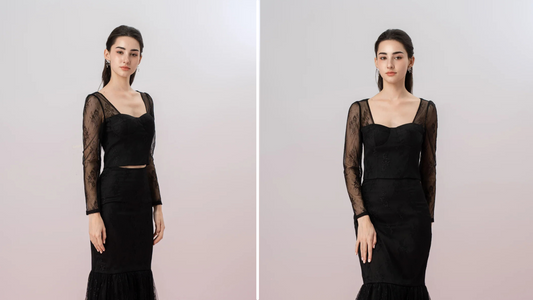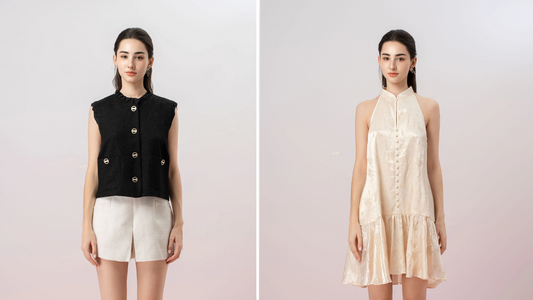As Chinese New Year approaches, the vibrant streets of Singapore come alive with festive decorations, traditional music, and the captivating sight of people dressed in elegant Cheongsams. The Cheongsam, also known as the Qipao, is a timeless and iconic dress that holds a significant place in Chinese culture and the hearts of Singaporeans.
In this article, we will embark on a journey to uncover the captivating history and evolution of the Cheongsam. From its humble beginnings as traditional Chinese clothing to its status as a fashion statement, the Cheongsam has transformed over the years while remaining deeply rooted in Chinese New Year traditions.
With its origins dating back to the 17th century, the Cheongsam has been influenced by various dynasties and cultural shifts, resulting in a distinctive and sophisticated design. Initially worn by the Manchu people during the Qing Dynasty, the Cheongsam gradually gained popularity among other ethnic groups, symbolizing unity and the blending of different cultures.
Over time, the Cheongsam became synonymous with elegance, femininity, and traditional Chinese aesthetics. Its figure-hugging silhouette accentuates the curves of the wearer, exuding grace and confidence. The dress's high collar, intricate embroidery, and beautiful fabric choices are a testament to the meticulous craftsmanship and attention to detail that define Chinese fashion.
The Cheongsam's evolution reflects the ever-changing landscape of fashion trends while embracing its cultural heritage. Modern interpretations of the dress incorporate contemporary elements that appeal to a wider audience, showcasing the versatility of this iconic garment. From playful patterns to bold colors, each Cheongsam bears a unique fusion of tradition and modernity.

During Chinese New Year in Singapore, the Cheongsam takes center stage as a beloved symbol of cultural pride. Its presence in family gatherings and festive celebrations pays homage to centuries of tradition, uniting generations and preserving Chinese customs.
In the upcoming sections, we will delve deeper into the origins, cultural significance, and stunning transformations of the Cheongsam. Join us as we explore the intricate journey of this captivating dress, from its traditional roots to its contemporary allure.
The Origins and Cultural Significance of Cheongsam
In this section, we will take a closer look at the origins and cultural significance of the Cheongsam. The Cheongsam has a rich history that dates back several centuries, originating as traditional Chinese clothing during the Qing Dynasty. It was originally known as the 'qipao' and was worn by women as a symbol of modesty and elegance.
Over time, the Cheongsam evolved in design and style, becoming more fitted and showcasing the female silhouette. The dress gained popularity among fashionable women in the early 20th century and became widely recognized as a quintessential Chinese garment.
The Cheongsam holds great cultural significance in Chinese society. It represents a fusion of traditional and modern elements, combining intricate craftsmanship with contemporary fashion trends. The dress embodies the essence of Chinese femininity, exuding grace, poise, and confidence.
During Chinese New Year, the Cheongsam takes on even greater importance. It is a customary attire worn by many during the festive season, symbolizing hope, prosperity, and good fortune in the coming year. By adorning the Cheongsam, individuals not only honor their cultural heritage but also participate in the vibrant traditions of Chinese New Year.
The Cheongsam has transcended its role as a traditional Chinese clothing item and has become a global fashion icon. It has been embraced by fashion designers around the world, who have incorporated its elegant design elements into modern clothing collections. Today, the Cheongsam is not only worn during Chinese New Year but also for special occasions, weddings, and formal events, showcasing its timeless allure and enduring style.

Evolution of Cheongsam: From a Traditional Attire to a Fashion Statement
In this section, we will trace the fascinating journey of the Cheongsam as it transformed from a traditional attire steeped in history into a modern fashion statement. Over the years, the design and style of the Cheongsam have evolved to cater to changing tastes and trends, while still maintaining its timeless elegance.
The Cheongsam's journey begins with its origins as a traditional Chinese dress. Initially, the Cheongsam was a loose-fitting garment worn by both men and women. However, it gradually evolved into a form-fitting silhouette that accentuated the female figure, symbolizing femininity and grace.
Adaptation to Contemporary Tastes
As Chinese fashion evolved and Western influences permeated, the Cheongsam underwent further modifications to adapt to contemporary tastes. Designers began experimenting with different fabrics, colors, and patterns, incorporating modern elements into the traditional design.
- Cheongsam design: The design of the Cheongsam shifted from loose and flowing to sleek and form-fitting, highlighting the curves of the wearer.
- Cheongsam style: Traditional patterns and motifs were replaced by more vibrant and contemporary designs, catering to the fashion preferences of the modern generation.
- Chinese fashion: The influence of Chinese fashion on the Cheongsam's evolution cannot be understated. As Chinese designers gained international recognition, they infused traditional elements into their designs, revitalizing the Cheongsam and elevating it to a global fashion icon.
Timeless Elegance and Design Elements
Despite its evolution, the Cheongsam has managed to retain its timeless elegance and distinctive design elements:
- Mandarin collar: The iconic high collar of the Cheongsam symbolizes refinement and sophistication, framing the wearer's face beautifully.
- Slit skirt: The side slit skirt adds a touch of allure and allows for ease of movement, while still maintaining the dress's classic silhouette.
- Qipao buttons: The intricate buttons, often made of precious materials such as jade or silk, serve as decorative accents and add a touch of opulence to the Cheongsam.
Today, the Cheongsam continues to be a fashion staple not only during Chinese New Year but also at various formal occasions and celebrations. Its ability to adapt and reinvent itself over time is a testament to its enduring popularity and timeless allure.

Conclusion
In conclusion, the Cheongsam holds a significant place in the history of Chinese cultural attire and has evolved from a traditional dress to a fashion statement that symbolizes elegance and beauty. With its origins deeply rooted in Chinese culture, the Cheongsam has become an iconic garment, especially during the Chinese New Year celebrations in Singapore.
Over the years, the Cheongsam has undergone a remarkable evolution to adapt to changing fashion trends while retaining its distinctive style. Its design has been influenced by various factors, including Chinese fashion and cultural influences. Despite these changes, the Cheongsam has managed to maintain its timeless appeal and charm.
Today, the Cheongsam not only represents traditional Chinese clothing, but it also serves as a powerful fashion statement. Its unique design and style are admired globally, making it a cherished attire not only during Chinese New Year but also for various formal events and special occasions throughout the year.





